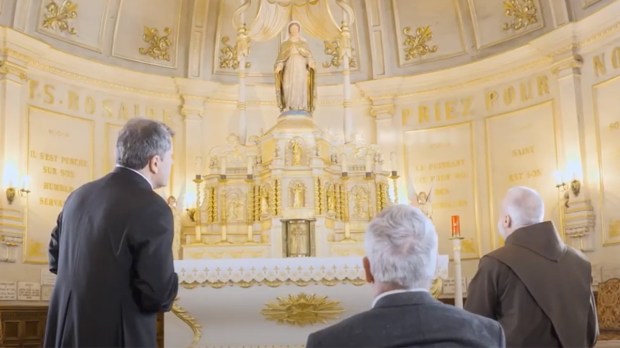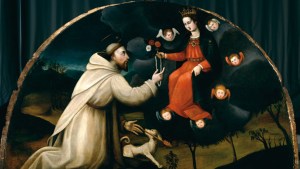Fr. Donald Calloway, a well-known Catholic priest, author and speaker, often hears people lament that Catholics in the U.S. and Canada don’t have a great shrine such as Our Lady of Lourdes, Our Lady of Fatima, or Our Lady of Guadalupe.
“My response is, ‘Oh, but we do: Our Lady of the Cape, the Queen of the Most Holy Rosary,” Fr. Calloway says in a new documentary about the shrine in Quebec Province.
Our Lady of the Cape, about halfway along the St. Lawrence River between Montreal and Quebec City, is Canada’s national shrine. Its history stretches back to the days when French missionaries brought the Gospel to the local native peoples.
Fr. Calloway is one of several experts interviewed for the new documentary, Bridge of Roses: The Story of Our Lady of the Cape. Produced by Dennis and Angelina Girard, directors of the Marian Devotional Movement, and Kevin Dunn, who wrote it and directed it, the film is scheduled for release on October 7, the Feast of Our Lady of the Rosary and the 450th anniversary of the Battle of Lepanto.
Interspersed amid dramatizations of key points in the shrine’s history, Fr. Calloway and others offer their perspectives on the shrine’s deeper meaning. Those commentators include Auxiliary Bishop Pierre-Olivier Tremblay of Trois-Rivières, Quebec, former rector of Our Lady of the Cape, and Dominican Fr. Lawrence Lew, worldwide promoter general of the Rosary for the Dominican Order.
Oldest chapel in North America
The story evolves from 1659, when a small wooden church was built at Cap-de-la-Madeleine. A chapter of the worldwide Confraternity of the Rosary, which was instrumental in the victory at the battle of Lepanto, was established at Cap-de-la-Madeleine in 1694. A larger stone chapel was built in 1714, and remains the oldest chapel in North America where daily Mass is still celebrated.
But the faith waned among the locals for many years. Its revival came about in quite a surprising way.
“In 1867, the pastor, who had really a dead parish, went into the chapel, really distraught because nobody came to confession on the feast of the Ascension, and he discovered a pig chewing on a rosary,” Girard said in an interview. “Fr. Luc Desilets, who discovered the swine picking up the rosary after men had dropped it, decided to devote himself to preaching about the confraternity and its benefits and preaching the Rosary, and within five years he had enrolled 3,000 people, not only in his parish community but all around the general area.”
Miracle on ice
Another fascinating part of the history that is dramatized is the freezing of part of the St. Lawrence River during an unusually warm winter in 1879. Fr. Desilets, still pastor, needed to find a way for workers to bring stones from the other side for construction of a larger church. A narrow part of the river froze enough to allow transportation of the stones — a miracle attributed to the praying of many rosaries. The ice stayed in place from the feast of St. Joseph, March 19, to the Solemnity of the Annunciation, March 25.
“Still today, I hear people saying to me, ‘My great-great-grandfather walked on it, and we’ve talked about it from generation to generation,” Bishop Tremblay says in the film.
It is from this miracle that Bridge of Roses derives its title. Our Lady of the Cape has had an even larger church since construction of the present basilica in the early 1960s, able to seat thousands. Girard and others are hopeful about the shrine’s potential for evangelization.
“Shrines have been places of powerful encounter and conversion,” Fr. Roger Vandenakker, general superior of the Companions of the Cross, says in the film.
In a day and age when there seems to be an ever-widening gulf between people of faith and those of none, between the cultures of life and death, or even in the midst of continuing pain from Canada’s residential schools legacy, the world might yet be ready for another miracle like the bridge of ice across the St. Lawrence, and the shrine built upon its shores.
To order the film, go to Bridge of Roses: The Story of Our Lady of the Cape.



